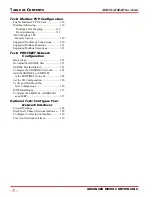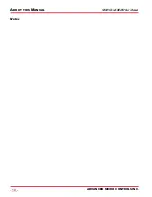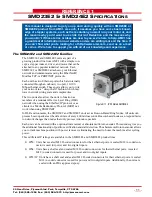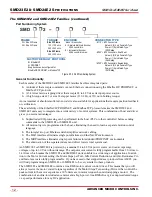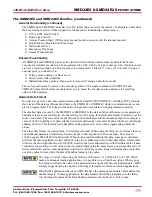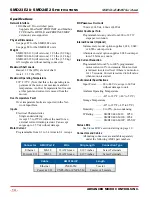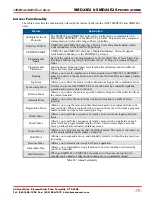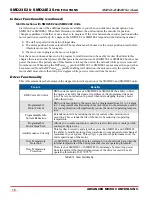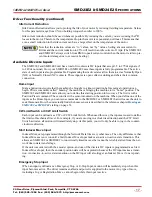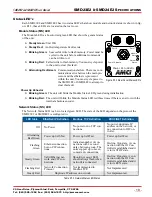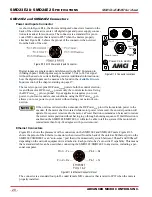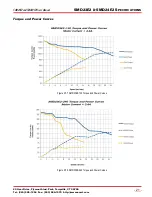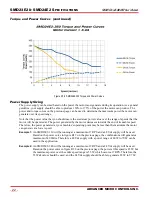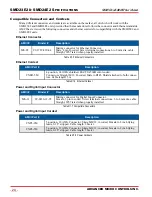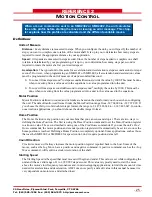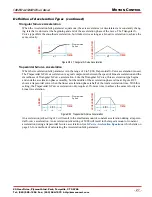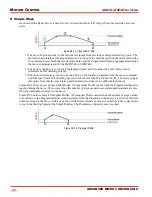
20 Gear Drive, Plymouth Ind. Park, Terryville, CT 06786
Tel: (860) 585-1254 Fax: (860) 584-1973 http://www.amci.com
SMD23E2 and SMD24E2 User’s Manual
SMD23E2 & SMD24E2 S
PECIFICATIONS
13
The SMD23E2 and SMD24E2 Families (continued)
General Functionality (continued)
The SMD23E2 and SMD24E2 units have two DC inputs that are used by the indexer. Configuration data from
the host sets the function of these inputs. Each input can be individually configured as a:
CW or CCW Limit Switch
Home Limit Switch
Capture Position Input (Will capture encoder position on units with the internal encoder.)
Stop Manual or Registration Move Input
Start Indexer Move
Emergency Stop Input
General Purpose Input
Encoder Functionality
All SMD23E2 and SMD24E2 units can be ordered with an internal incremental or absolute multi-turn
encoder. Incremental encoders can be programmed to 1,024, 2,048, or 4,069 counts per turn. Absolute encod-
ers have a fixed resolution of 2,048 counts per turn and encode a total of 2
21
turns. (32 bits total.) Using an
encoder gives you the ability to:
Verify position during or after a move
Detect motor stall conditions
Maintain machine position when power is removed if using an absolute encoder.
The motor position can be preset to the encoder position with a single command. All SMD23E2 and
SMD24E2 units with absolute encoders allow you to preset the encoder position and save the resulting
offset in Flash memory.
Network Data Format
In order to support any host that communicates with the EtherNet/IP, PROFINET, or Modbus TCP protocols,
the format of the data read from and written to the SMD23E2 or SMD24E2 while in command mode is com-
pletely programmable. The format of the network input and output data can be programmed separately.
The smallest data size used by the SMD23E2 or SMD24E2 is the sixteen bit word, however some parameters
and data values can exceed this size. For these thirty-two bit values, the default data format is referred to as the
multi-word
format. The data value is split between the hundreds digit and the thousands digit. For example, a
value of 12,345 would have 12 placed in the first (lower addressed) word, and 345 placed in the second (higher
addressed) word. This format greatly simplifies setting parameter values when programming command
blocks.
The other data format is a signed thirty-two bit integer format. When using the thirty-two bit format, there is
one additional parameter named
Data Endian
. Its use is best explained with an example. The value of
123,456 equals 0001:E240 in hexadecimal. When storing and transmitting this data, some host controllers
will store the least significant word (16#E240) in the lower addressed word in their data tables, while others
will store the most significant word (16#0001) stored in the lower addressed word in their data tables. These
controllers expect thirty-two bit values to be returned to them using the same format. Least significant word
first is called
little endian
, most significant word first is called
big endian
. Rockwell Automation controllers
use
little endian
format, while the default Modbus format is
big endian
.
The range of values when using the multi-word format is -32,768,000 to 32,767,999. When
used in continuous rotation applications, it is possible to overflow these values. When a posi-
tion value overflows, the value of the associated data words will become indeterminate. AMCI
strongly suggests using the signed 32-bit integer format for continuous rotation applications.
EtherNet/IP applications that use an EDS file have the parameters and data values defined as
double integers. In these applications, the data formats should be programmed to the thirty-
two bit integer format and the Data Endian parameter should be set to
little endian
.






